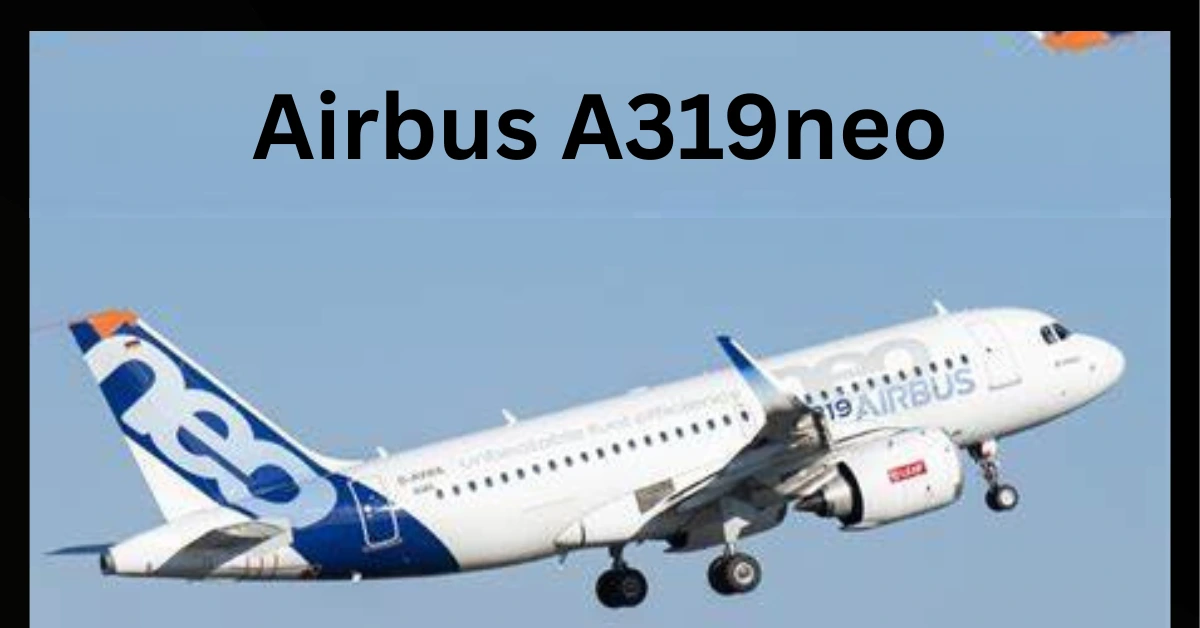What Is the Airbus A319neo?
In the fast-evolving world of aviation technology, efficiency is king, and the Airbus A319neo proves just that. Engineered with cutting-edge propulsion systems, state-of-the-art aerodynama319ics, and digital cockpit enhancements, the A319neo is Airbus’s answer to modern operational challenges in constrained environments. Powered by next-gen LEAP-1A or PW1100G-JM engines, it offers up to 20% greater fuel efficiency, longer range, and reduced emissions, all packed into a compact, narrow-body design.
Built on the robust legacy of the A319ceo but reimagined for the 21st century, the A319neo caters to airlines operating at high altitudes, short runways, and specialized routes where performance, reliability, and flexibility are non-negotiable. From its fly-by-wire controls to its Airspace cabin tech, this aircraft is a marvel of modern aerospace engineering.
Evolution of the Airbus A319neo: Development Timeline and Background
The Airbus A319neo originates from the renowned A320 family, which made its debut in the late 1980s. As airlines began seeking more fuel-efficient, environmentally friendly, and lower-cost alternatives in the early 2010s, Airbus introduced the NEO (New Engine Option) program, aimed at extending the life and performance of its single-aisle aircraft line.
Officially launched in 2010, the NEO program included three variants: the A319neo, A320neo, and A321neo. Unlike the A320neo and A321neo, which quickly became popular for their larger capacity and route versatility, the A319neo was designed to meet more specific needs—such as short-haul travel, operations at high-altitude airports, and specialized use by governments or VIPs.
The A319neo made its first flight on March 31, 2017, in Hamburg, Germany. It was equipped with CFM LEAP-1A engines and underwent a series of rigorous flight tests to validate its performance, range, noise reduction, and environmental compliance. Later, Airbus also tested the Pratt & Whitney PW1100G-JM engine variant.
In 2018, the A319neo earned full certification from both the European Union Aviation Safety Agency (EASA) and the U.S. Federal Aviation Administration (FAA), confirming its compliance with international aviation standards. Despite a relatively slower commercial uptake compared to its larger siblings, Airbus continued to invest in the model’s capabilities, focusing on specialized operators, private jets (ACJ319neo), and countries with challenging aviation geographies.
Today, the A319neo is recognized as a low-demand, high-performance aircraft that excels in environments where other narrow-body jets struggle to operate efficiently. It remains a strategic option for operators seeking short-runway flexibility, high-climb performance, and reduced carbon emissions in a compact frame.
Airbus A319neo Specs Overview
Advanced Engine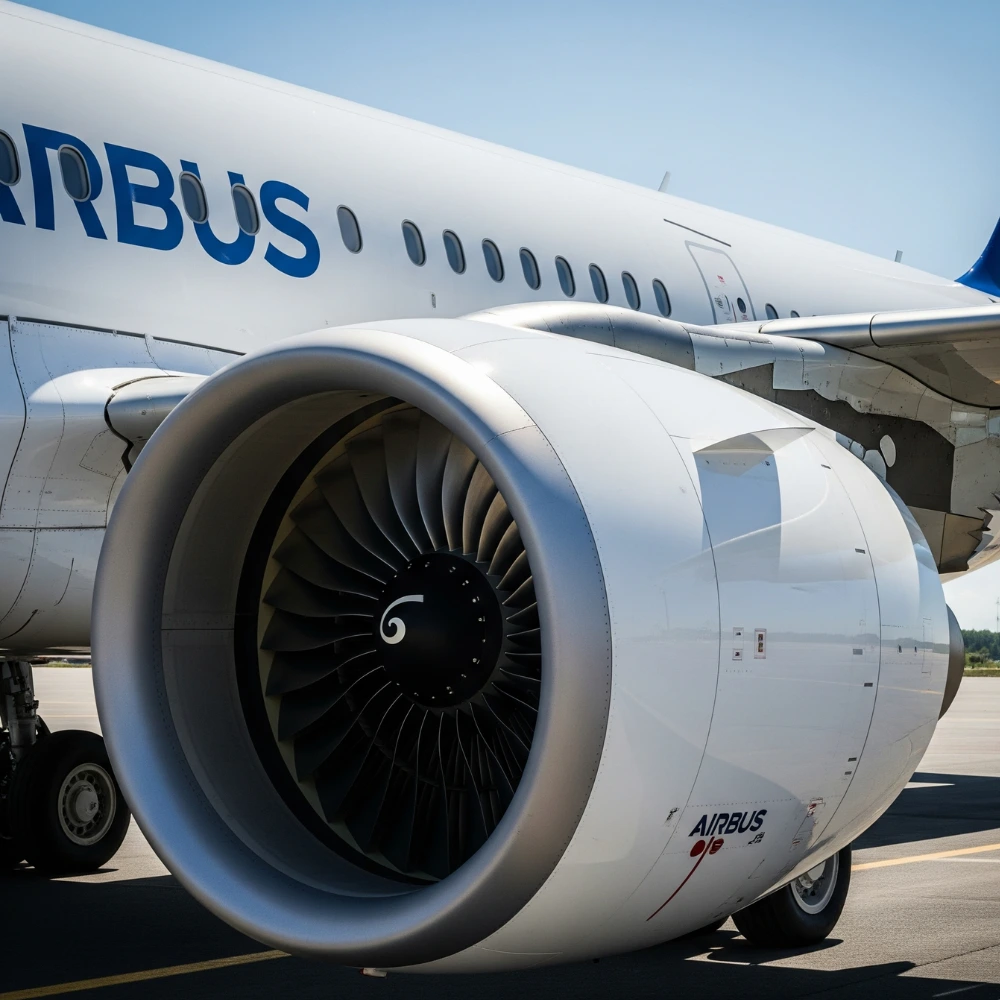
The Airbus A319neo gives operators the choice between two cutting-edge engine models: the CFM International LEAP-1A and the Pratt & Whitney PW1100G-JM. Both engines are part of the new-generation propulsion systems designed to deliver better fuel economy, lower emissions, and superior performance compared to previous models.
CFM LEAP-1A Engine: Power, Efficiency, and Reliability
The LEAP-1A engine, developed by CFM International, is a key technological upgrade for the A319neo. Built with composite fan blades, 3D woven carbon fiber, and ceramic matrix composites, it provides a 15–20% reduction in fuel burn compared to the older A319ceo. This engine also significantly reduces CO₂ emissions and noise pollution, making it an ideal choice for airports with strict environmental regulations. With lower maintenance needs and high dispatch reliability, the LEAP-1A is widely favored by airlines that prioritize operational cost-efficiency and sustainability.
Pratt & Whitney PW1100G-JM Engine: The Geared Turbofan Advantage
The PW1100G-JM engine from Pratt & Whitney is another revolutionary option for the Airbus A319neo. It features geared turbofan technology, which separates the fan from the low-pressure turbine, allowing each to operate at optimal speeds. This results in greater fuel efficiency, reduced engine wear, and lower noise output. The PW1100G-JM not only offers quiet and smooth operation but also contributes to long-term fuel savings, making it an excellent fit for carriers seeking both environmental and economic performance.
Lower Fuel Burn: Higher Savings and Sustainability
One of the A319neo’s most important selling points is its 20% lower fuel consumption per seat compared to the A319ceo. This is achieved through a combination of next-gen engines, advanced aerodynamics, and lighter materials used in construction. For airlines, this translates into millions in annual fuel savings, lower carbon emissions, and improved environmental compliance. In today’s aviation market, where fuel costs and sustainability goals are critical, this efficiency gives the A319neo a distinct competitive advantage.
Long-Range Capabilities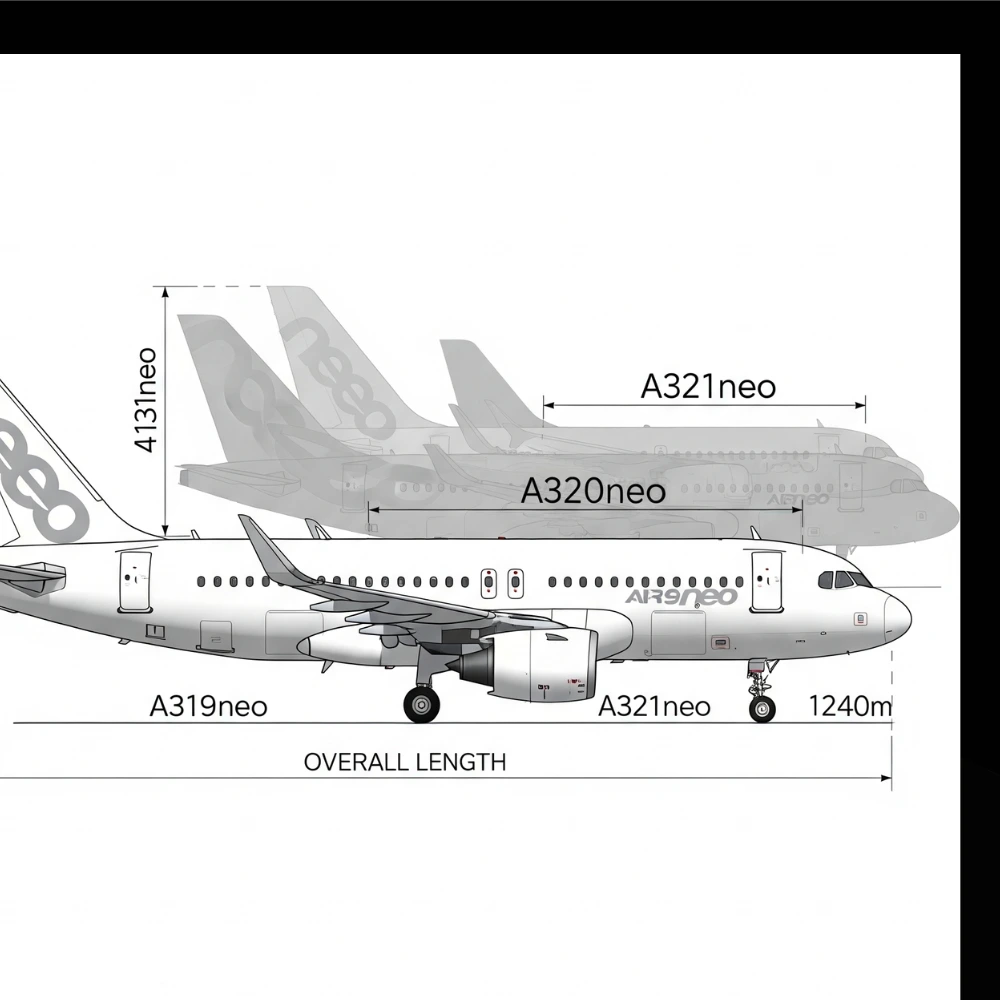
Maximum Range of Up to 6,950 Kilometers
The A319neo offers an impressive maximum range of 6,950 kilometers (3,750 nautical miles), noticeably exceeding the performance of its predecessor, the A319ceo. This range improvement allows airlines to connect secondary cities to major hubs without needing to upsize their aircraft. The aircraft is ideal for routes such as Western Europe to the U.S. East Coast, South America to Central or North America, or intra-Asia connections where direct flights with right-sized capacity are in demand.
A Perfect Fit for Long Domestic and Transcontinental Flights
With its extended range and impressive fuel efficiency, the A319neo is ideally suited for domestic long-haul and short-to-medium international routes. Airlines can fly longer distances without refueling stops, reducing operational costs and improving turnaround efficiency. For example, flights between New York and San Diego, London and Dubai, or São Paulo and Lima can be operated with full passenger and cargo loads, making it an excellent tool for expanding network coverage economically.
Unlocking Intercontinental Opportunities for Smaller Airlines
Smaller and regional carriers with intercontinental ambitions often struggle to justify the cost of wide-body jets. The A319neo fills that gap by offering intercontinental performance in a single-aisle format, which minimizes fuel costs while maximizing reach. Its range enables airlines to launch new nonstop international routes, bypassing congested hub airports and serving underserved city pairs, helping them compete more effectively in a globalized market.
A319neo Length Overview
The A319neo has an overall length of 33.84 meters (111 feet), which is shorter than both the A320neo and A321neo. This compact size allows the aircraft to operate efficiently at airports with limited gate space or short runways, especially in high-altitude or urban locations where maneuverability matters. Despite its reduced length, the aircraft still offers a roomy cabin and can accommodate 120 to 150 passengers, depending on the seating configuration.
Shorter Body, Stronger Operational Reach
Thanks to its reduced length, the A319neo can achieve better performance in challenging environments, such as mountainous airports (e.g., Lukla, Kathmandu, La Paz) or remote island runways. It also performs exceptionally well on quick turnaround routes, where faster boarding and deplaning can significantly boost operational efficiency. This size advantage makes it a go-to choice for:
- Government and military transport
- VIP and executive travel
- Regional carriers with performance-based needs
Comparing Length Across the A320neo Family
| Model | Length (meters) | Typical Seats |
| A319neo | 33.84 m | 120–150 |
| A320neo | 37.57 m | 150–180 |
| A321neo | 44.51 m | 180–230 |
A319neo Wingspan Overview
The Airbus A319neo is designed with modern aerodynamic enhancements, and its wingspan plays a crucial role in optimizing flight performance, fuel efficiency, and stability. The aircraft’s wider wingspan reduces drag and smooths airflow, making it ideal for both short and medium-haul operations.
Wingspan Dimensions: 35.8 Meters With Sharklets
The A319neo features a wingspan of 35.8 meters (117.45 feet) when equipped with Airbus Sharklets, wingtip devices that are now standard across the NEO family. These upward-curved extensions increase the lift-to-drag ratio, directly lowering fuel burn and enhancing aerodynamic performance. The increased wingspan compared to the A319ceo not only enhances efficiency but also provides greater stability during turbulent conditions and better handling at lower speeds.
Aerodynamic Advantage of Sharklets
The Sharklets on the A319neo reduce aerodynamic drag and allow the aircraft to climb faster and cruise more efficiently. These advanced wingtips contribute to an estimated up to 4% fuel savings on longer routes, while also enabling better takeoff performance from short or high-altitude runways. This improvement in wing design helps airlines meet sustainability goals by reducing emissions and fuel consumption per flight.
Comparing A319neo Wingspan to Other Models
| Aircraft Model | Wingspan (with Sharklets) | Notes |
| A319neo | 35.8 meters | Compact yet high-performing |
| A320neo | 35.8 meters | Standard mid-size variant |
| A321neo | 35.8 meters | Same span, longer fuselage |
How Wingspan Impacts Operational Flexibility
Despite its wide wingspan, the A319neo fits into Category C airport gates, making it compatible with most commercial airports around the world. The A319neo combines aerodynamic efficiency with easy ground handling, ensuring smooth operations without sacrificing compatibility with existing airport infrastructure.
A319neo Weight Specifications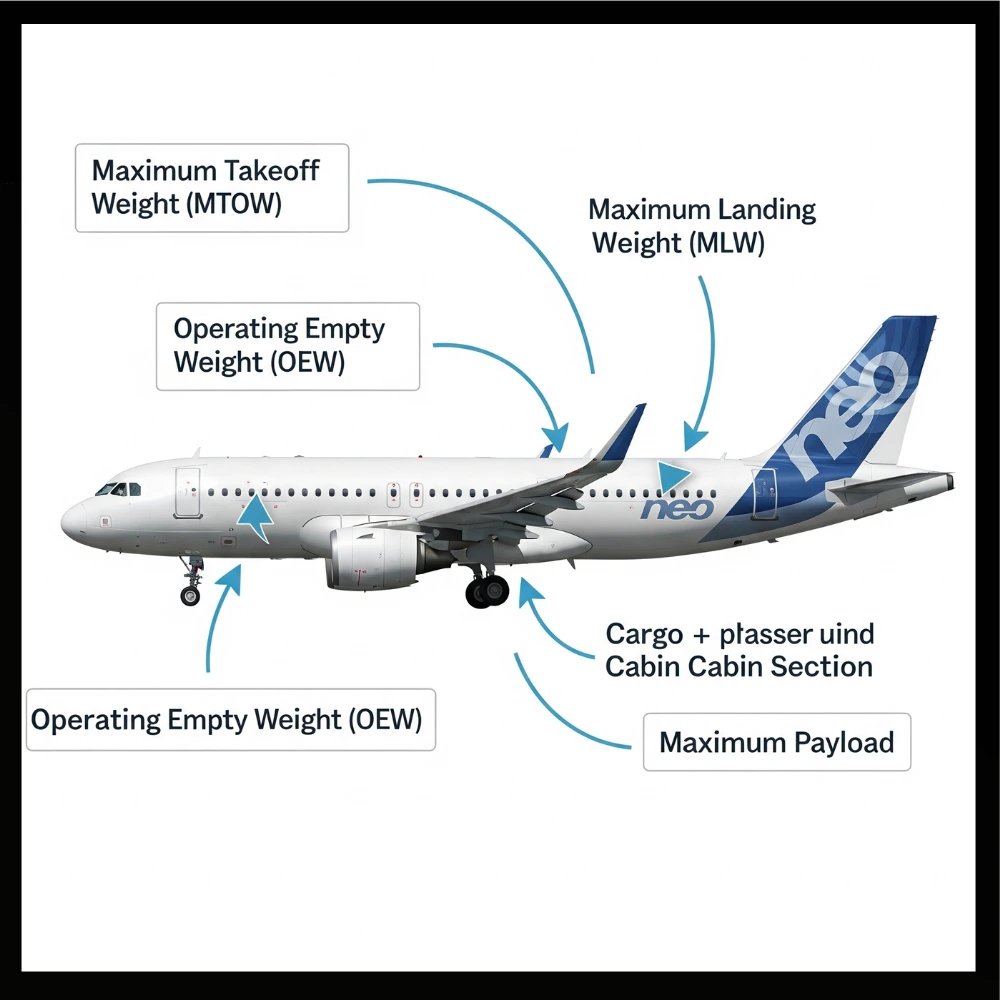
The Airbus A319neo offers a well-balanced weight profile that contributes to its outstanding fuel efficiency, performance, and operational flexibility. Its carefully engineered structure enables the aircraft to handle both short and long routes while maintaining low fuel burn and excellent climb rates.
Maximum Takeoff Weight (MTOW): Up to 75.5 Tons
The Maximum Takeoff Weight (MTOW) of the A319neo reaches 75,500 kilograms (166,500 pounds). This increased weight capacity, compared to the A319ceo, allows the aircraft to carry more fuel, passengers, and cargo, which directly supports its extended range of up to 6,950 km.
Maximum Landing Weight (MLW): Designed for Safe Recovery
The A319neo has a Maximum Landing Weight (MLW) of 64,300 kilograms (141,700 pounds). This ensures safe landings even with a partially full fuel tank, offering greater route flexibility and safety margins, especially during diversions or shorter flight legs.
Operating Empty Weight (OEW): Fuel Efficiency in Focus
The Operating Empty Weight (OEW) of the A319neo varies slightly based on configuration, but it typically falls around 40,000 to 42,000 kilograms. This relatively low OEW, achieved through advanced lightweight materials and aerodynamic design, improves fuel efficiency and payload capacity. A lower OEW means airlines can carry more passengers or cargo without exceeding performance thresholds, especially on high-altitude or short-runway routes.
Maximum Zero Fuel Weight (MZFW): Balancing Load and Safety
The Maximum Zero Fuel Weight (MZFW) for the A319neo is approximately 61,000 kilograms. This figure represents the aircraft’s maximum permissible weight without fuel. It helps airlines optimize the balance between passenger, baggage, and cargo load, ensuring safe operations across all route types.
A319neo Cockpit Overview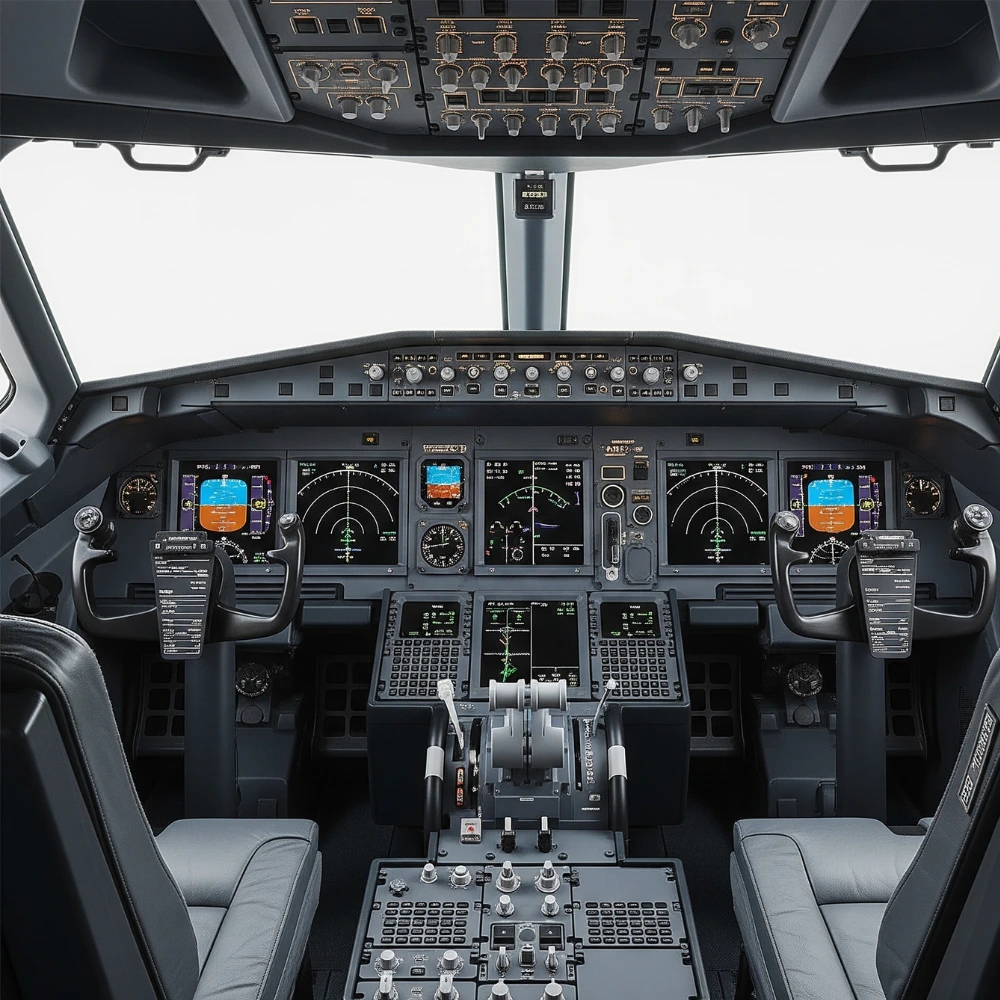
Fully Digital Flight Deck
The A319neo is equipped with a fully digital glass cockpit, featuring six large LCD screens that replace traditional analog instruments. These displays provide real-time information for navigation, flight controls, engine monitoring, and systems diagnostics, all in a clear, organized layout. Pilots benefit from a streamlined interface that reduces workload and improves flight planning accuracy, especially on longer or more complex routes.
Fly-By-Wire Controls and Sidestick Inputs
The A319neo’s cockpit integrates advanced fly-by-wire flight control technology, replacing traditional mechanical linkages with precise electronic signaling for improved pilot control and flight safety. Pilots operate the aircraft using sidestick controllers, which are ergonomically positioned and enhance manual control precision. This system improves handling, optimizes fuel efficiency, and automatically adjusts flight parameters to maintain safe operations in varying conditions, including turbulence or high-altitude scenarios.
Enhanced Avionics and Navigation Systems
The aircraft is fitted with the latest avionics suite, which includes advanced systems for GPS navigation, weather radar, collision avoidance (TCAS), and auto-thrust management. These systems ensure safer and more efficient operations across all phases of flight. Integration with Flight Management Systems (FMS) and modern communication tools allows the cockpit crew to manage flight routes, altitude changes, and performance metrics with ease.
Common Type Rating Across the NEO Family
A key operational advantage of the A319neo is its shared type rating with the A320neo and A321neo, allowing pilots to transition between models without extensive additional training. This means pilots trained on one NEO variant can easily switch between models without extensive retraining, saving airlines time and costs while maintaining crew scheduling flexibility.
Cockpit Comfort and Ergonomics
In addition to its advanced systems, the A319neo cockpit is designed with pilot comfort and ergonomic efficiency in mind, ensuring easier control access and reduced fatigue during flights. Adjustable seating, optimal sightlines, intuitive control placement, and reduced noise levels ensure pilots can perform at their best, even on long flights. Additional features like head-up display (HUD) compatibility, tablet mounts, and electronic flight bags (EFBs) further modernize the workspace and improve decision-making in real time.
Airbus A319neo Seat Configuration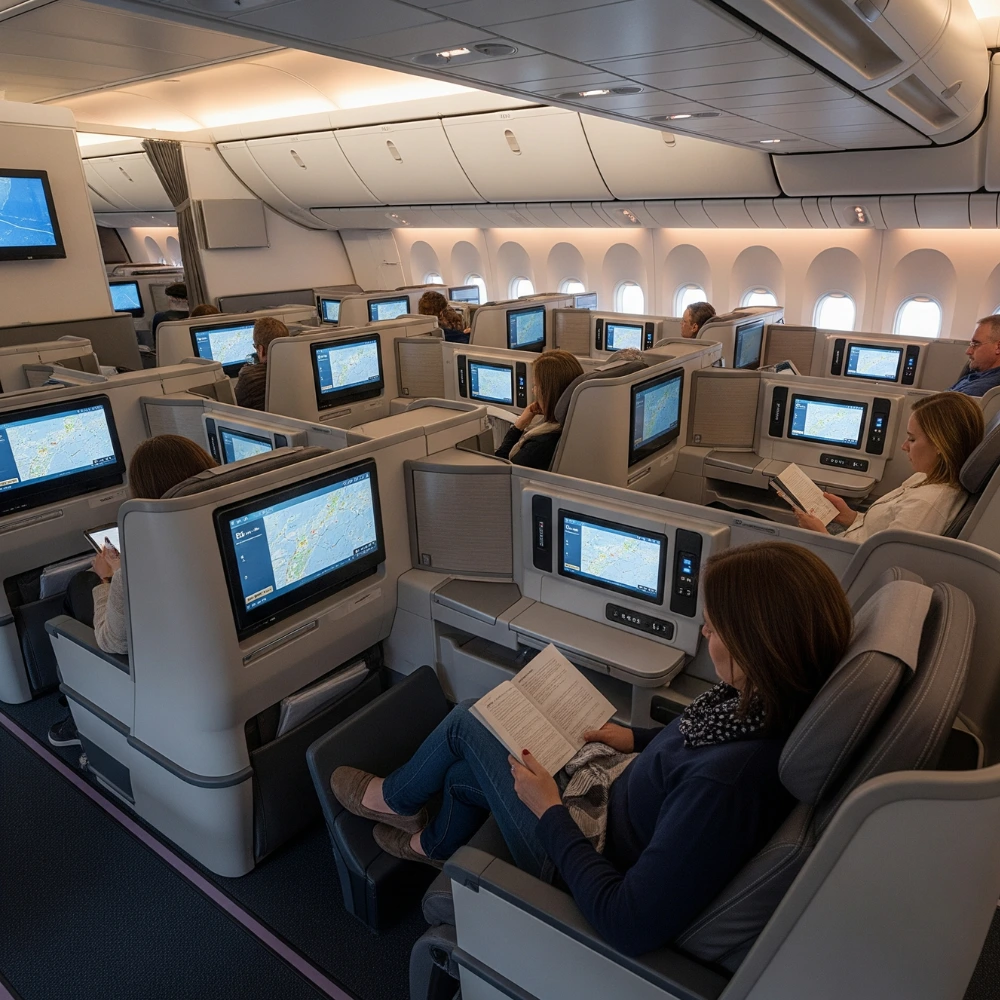
The West Air A319neo is designed to accommodate 144 passengers, offering two seating classes: Premium Economy and Economy Class. The layout balances comfort with efficiency, making it suitable for short to medium-haul routes.
Premium Economy Class
West Air’s Premium Economy cabin features 18 seats located in the first three rows. Passengers in this section enjoy more spacious seating, especially in the first row, which offers slightly more room, although stretching out completely may still be limited. A lavatory and galley are positioned at the front, near the main boarding door, for easy access. These seats provide:
- Seat pitch of approximately 34 inches, giving travelers extra legroom
- Seat width of 18 inches, ensuring a comfortable seating experience
- Recline of around 3 inches, enough for moderate relaxation
Economy Class
The Economy cabin holds 126 seats arranged in a 3-3 configuration across the aisle. Here’s what passengers can expect:
- Seat pitch ranges from 29 to 30 inches, depending on the row
- Seat width remains a consistent 18 inches
- Seat recline is around 3 inches, providing minimal tilt
- Basic in design, these seats are functional but come without advanced in-flight amenities.
- Row 10 is an exit row, offering extra legroom ideal for taller passengers
- Row 24 has slightly narrower seats and a misaligned window, which might affect the view and comfort
Airbus A319neo Seat Comparison: Premium Economy vs. Economy
| Feature | Premium Economy | Economy |
|---|---|---|
| Total Seats | 18 | 126 |
| Seat Pitch | 34 inches (approx. 86 cm) | 29–30 inches (approx. 74–76 cm) |
| Seat Width | 18 inches (approx. 46 cm) | 18 inches (approx. 46 cm) |
| Seat Recline | 3 inches | 3 inches |
| Seat Layout | Front 3 rows | 6-abreast layout throughout the cabin |
| Legroom | Extra legroom, especially in the first row | Standard legroom; extra legroom at exit row (Row 10) |
| Stretch Space | Slightly more, but full stretch is still limited | Limited; less space in rear seats |
| Window Alignment | Proper alignment | Misaligned window at Row 24 |
| Lavatory Access | Front of cabin (near galley and main entrance) | Rear of the cabin |
| Best For | Business flyers, comfort seekers on short to mid routes | Budget travelers and short-haul passengers |
Airspace Cabin Specs & Comfort Features
The Airbus A319neo comes equipped with the innovative Airspace cabin, designed to elevate the passenger experience on every journey. This next-generation cabin architecture focuses on space optimization, comfort, and modern aesthetics, making it ideal for regional and medium-haul routes.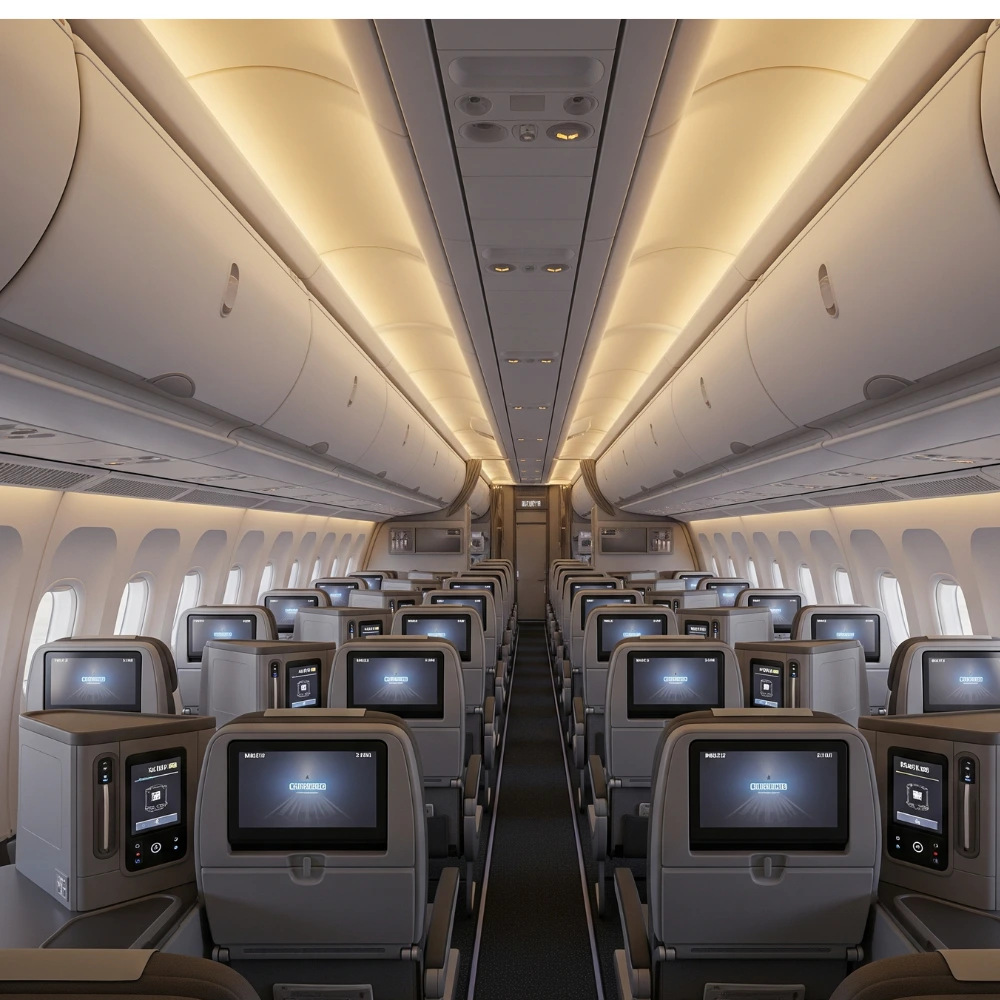
Larger Overhead Storage Bins
Passengers benefit from 60% more overhead bin space compared to previous cabin models. These “XL bins” are designed to fit larger carry-on bags vertically, making boarding and deplaning faster while reducing in-flight clutter.
Quieter Cabin Environment
The A319neo’s cabin features advanced sound insulation, significantly reducing noise from engines and airflow. This results in a calmer and quieter travel experience, especially valuable for early morning or overnight flights.
LED Mood Lighting
The customizable LED lighting system automatically adjusts during different phases of the flight (boarding, takeoff, cruising, landing). It simulates natural circadian rhythms, reducing jet lag and enhancing overall well-being during longer flights.
Enhanced Air Quality & Temperature Control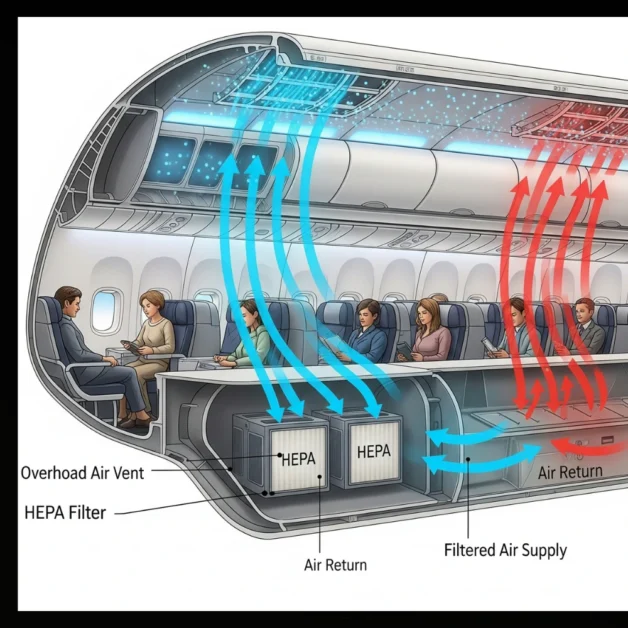
With advanced air circulation systems and precision temperature control, the A319neo ensures a fresh and evenly distributed cabin environment. Passengers enjoy cleaner air and consistent comfort throughout the flight, regardless of their seat location.
Sleek, Modern Cabin Aesthetics
The Airspace cabin is designed with sleek contours, subtle color palettes, and smart lighting systems that together deliver a modern, open, and inviting atmosphere. Every design element is focused on making passengers feel relaxed and refreshed.
Ideal for Regional and Business Routes
These cabin enhancements make the A319neo especially attractive to airlines operating high-frequency regional routes and premium business markets, where passenger comfort plays a key role in loyalty and satisfaction.
In-Flight Comfort and Amenities on the Airbus A319neo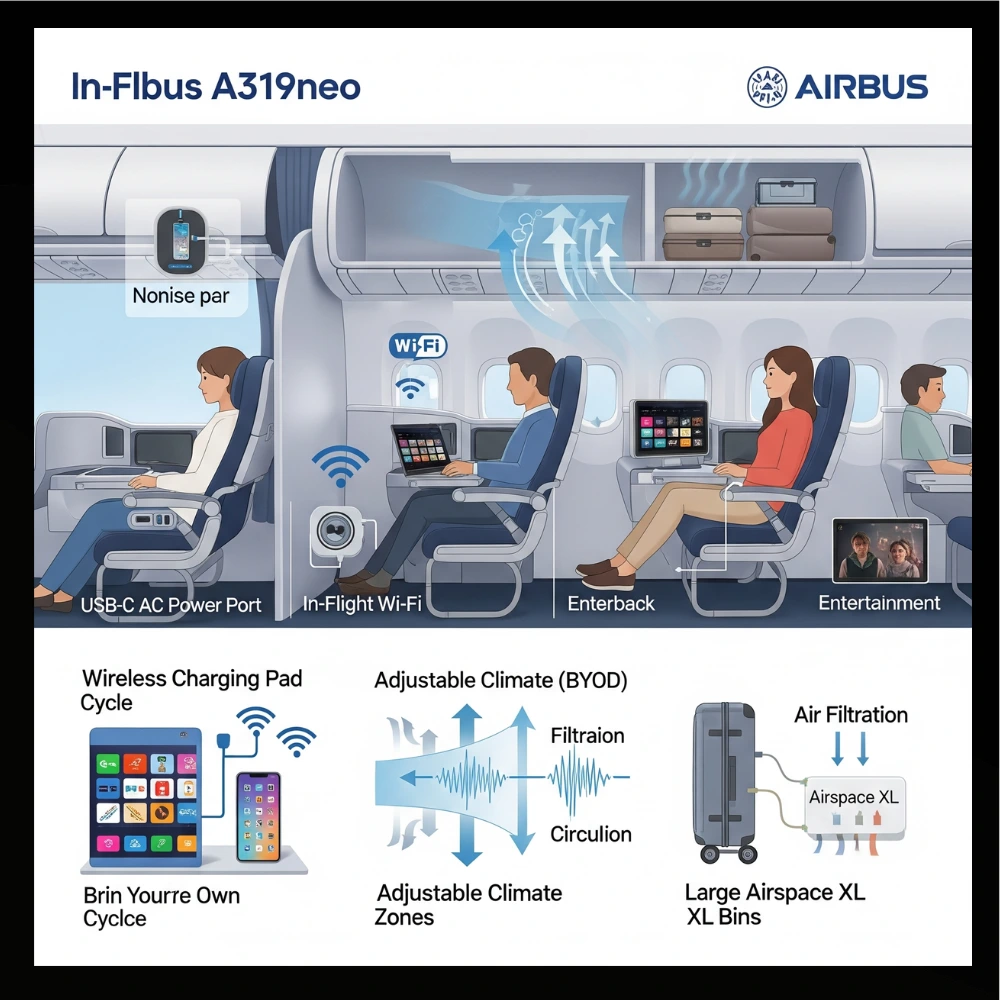
The Airbus A319neo may be a narrow-body jet, but it’s designed with wide-body comfort in mind.
Power and Charging Options
- Many airlines equip each seat with USB-A or USB-C charging ports for smartphones and tablets.
- AC power outlets are commonly available in Premium Economy or Business Class cabins.
- Some carriers also include wireless charging pads in newer cabin layouts.
Wi-Fi and Connectivity
- High-speed Wi-Fi is available on most A319neo aircraft, depending on the airline’s package.
- Passengers can stream content, browse the web, or work remotely during flights.
- Many systems support air-to-ground or satellite-based internet, delivering a reliable connection even on long-haul routes.
In-Flight Entertainment (IFE)
- Airlines may install seatback touchscreens offering a range of movies, TV shows, games, and music.
- Bring-your-own-device (BYOD) streaming is also popular, allowing passengers to connect via the onboard network using their phones or tablets.
- Noise-reducing environments help create a better viewing or listening experience.
Improved Cabin Air and Climate Control
- Advanced air filtration systems refresh cabin air every 2–3 minutes.
- Temperature zones can be individually managed across different parts of the cabin.
- Passengers benefit from more stable humidity and cleaner air, which reduces fatigue.
Spacious Overhead Storage
The A319neo includes Airbus’s new Airspace XL bins, which:
- The overhead bins are designed to accommodate larger carry-on bags placed wheels-first, allowing for quicker boarding and easier access.
- Fit larger carry-ons wheels-first for easy access and faster boarding.
- Reduce clutter in the aisles, improving the cabin’s open feel.
A319neo Cruise Speed Explained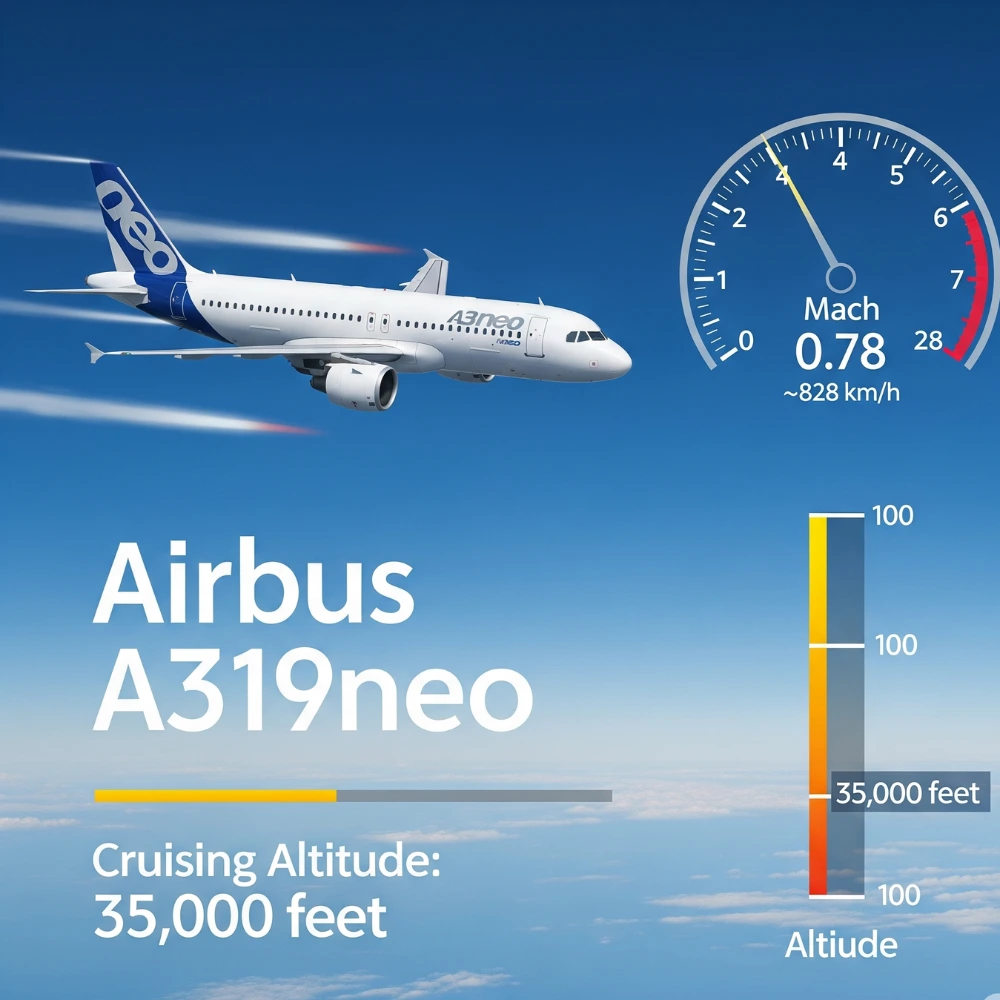
Efficient Cruising Performance
The Airbus A319neo cruises at a speed of Mach 0.78, which is approximately 828 km/h (514 mph) at cruising altitude. This speed strikes an ideal balance between fuel efficiency and on-time performance, especially for short to medium-haul routes.
Why Cruise Speed Matters
Cruise speed is the average speed an aircraft maintains during the majority of its flight, usually at altitudes between 30,000 to 40,000 feet. For airlines, maintaining an efficient cruise speed helps:
- Optimize fuel consumption
- Meet tight flight schedules
- Minimize engine wear and tear
- Ensure passenger comfort by reducing turbulence exposure
Compared to Older Models
Compared to the older A319ceo (current engine option), the A319neo maintains a similar cruise speed but delivers better aerodynamic performance and fuel savings, thanks to its:
- Next-generation engines (LEAP-1A / PW1100G-JM)
- Sharklet wingtips
- Improved aerodynamics
Real-World Efficiency
With this cruising speed, the A319neo can cover longer routes in less time while maintaining lower emissions, making it an excellent fit for modern airline networks trying to reduce carbon footprints without compromising service speed.
A319neo Safety Features & Standards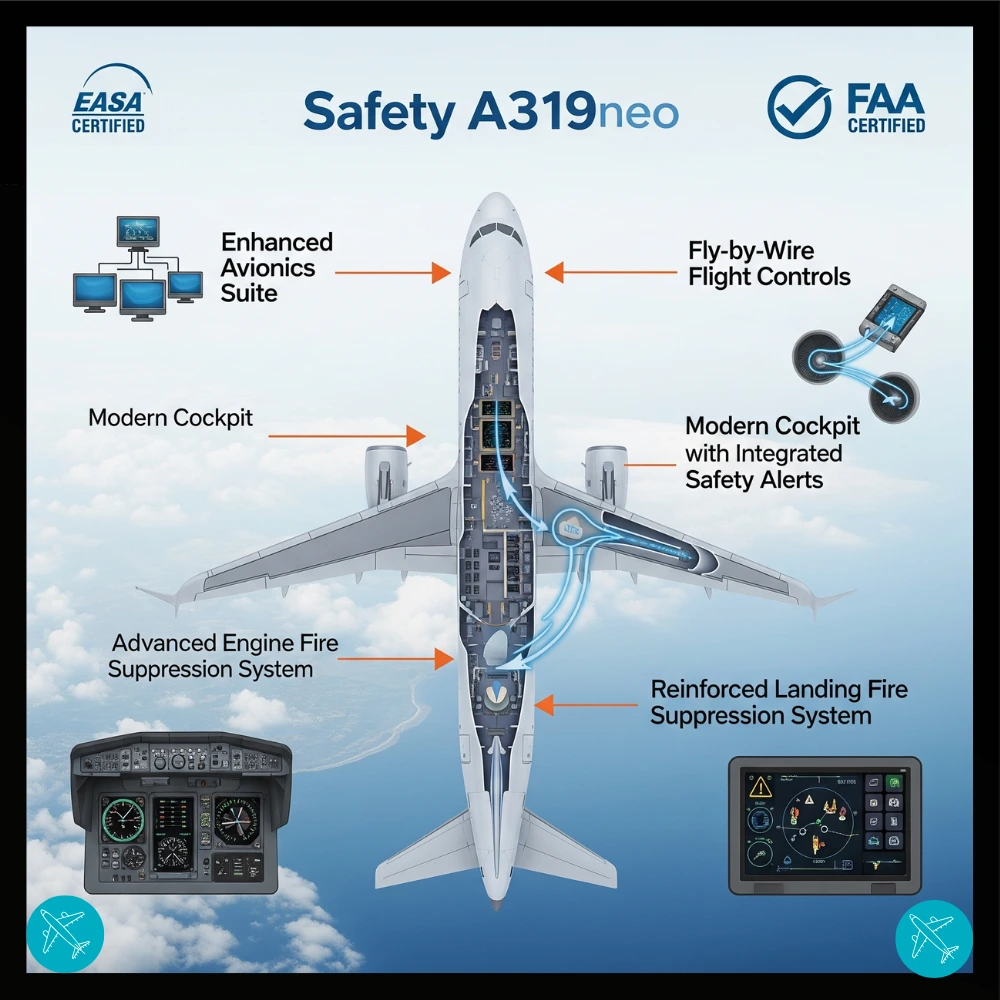
Built for Next-Gen Flight Safety
The Airbus A319neo is designed with cutting-edge safety features that meet and exceed the latest EASA and FAA aviation regulations. From cockpit technology to cabin systems, everything is optimized to ensure safe, smooth, and reliable operations.
Advanced Flight Deck Safety
The A319neo includes fly-by-wire technology, replacing manual flight controls with digital systems that offer more precision and reduced pilot workload. A side-stick control system gives pilots intuitive handling and improved situational awareness. Integrated Electronic Flight Instrument Systems (EFIS) enhance real-time monitoring, warning, and system status displays.
Enhanced Structural & System Integrity
The aircraft’s fuselage and wings are built with advanced composite materials, increasing strength and durability while reducing weight. Multiple redundant systems (for hydraulics, electrics, and flight control) ensure that if one system fails, backups instantly take over. Modern avionics suites actively monitor thousands of parameters to detect and report issues early.
Improved Landing & Ground Safety
Equipped with autobrake and anti-skid systems, the A319neo ensures safer landings, especially in wet or short runways. The advanced ground proximity warning system (EGPWS) helps avoid terrain collisions. The Runway Overrun Awareness and Alerting System (ROAAS) actively alerts pilots to prevent landing overruns.
Cabin & Emergency Preparedness
The cabin includes automated fire detection and suppression systems in cargo and lavatory areas. Emergency lighting, oxygen masks, and exits are marked and accessible, following international safety standards. Flight attendants receive rigorous training for handling in-flight emergencies and evacuations quickly and efficiently.
Certified Safety Compliance
The A319neo complies with the latest CS-25 (Certification Specifications for Large Aeroplanes) from EASA and FAR Part 25 standards from the FAA. Regular airworthiness inspections, airline maintenance schedules, and real-time aircraft health monitoring systems (AHMS) ensure continued safety during operations.
Runway Overrun Protection: ROAAS in the A319neo
What is ROAAS?
The Runway Overrun Awareness and Alerting System (ROAAS) is a new safety feature introduced in the Airbus A319neo. It is designed to reduce the risk of runway overruns during landing, which are among the most common yet dangerous types of aviation accidents.
How ROAAS Works?
ROAAS uses real-time data from multiple onboard systems, including aircraft speed, runway length, and braking efficiency, to predict whether the aircraft can safely stop on the remaining runway. If the system detects any risk, it immediately alerts the pilots to take corrective action.
Benefits of ROAAS
- Enhances pilot situational awareness during landing
- Reduces runway excursion incidents
- Improves passenger and crew safety
- Supports compliance with modern aviation safety standards
Predictive Maintenance & Smart Analytics
What is Predictive Maintenance?
Predictive maintenance is a proactive approach that relies on real-time data, sensors, and analytics to monitor the health of the aircraft. Instead of waiting for something to go wrong, this technology allows airlines to fix issues before failures happen.
How It Works in the A319neo
The A319neo is equipped with hundreds of built-in sensors that constantly monitor systems like engines, hydraulics, avionics, brakes, and landing gear. These sensors send data to Airbus’s Skywise data platform, where powerful algorithms analyze the information and:
- Identify unusual patterns
- Detect potential malfunctions
- Recommend corrective action in advance
Benefits for Airlines
This advanced system offers several key advantages:
- Reduced unplanned downtime
- Lower maintenance costs
- Fewer flight cancellations or delays
- Improved fleet reliability
- Better parts inventory planning
Enhanced Passenger Experience
By reducing the chance of in-flight failures and unexpected delays, predictive maintenance ensures smoother operations and higher on-time performance. This directly improves customer satisfaction and airline reputation.
Eco-Friendly Operations
Efficient maintenance planning also helps airlines operate more sustainably, as well-maintained aircraft use less fuel and reduce unnecessary emissions caused by emergency repairs or last-minute route changes.
A319neo Performance in High-Altitude Airports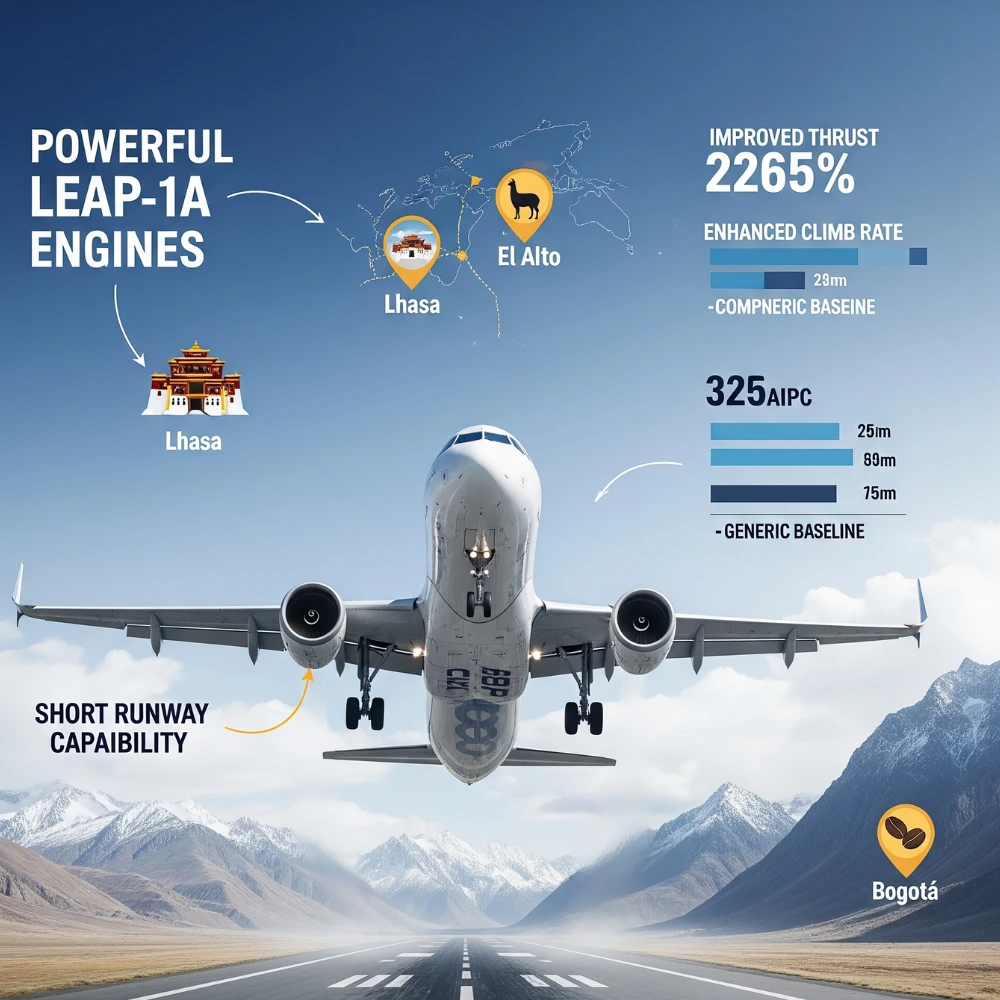
The Airbus A319neo is particularly ideal for high-altitude airports, where reduced air density and shorter runways demand enhanced takeoff and landing capabilities. Its engine power, wing design, and weight distribution make it a smart choice for airlines serving mountainous regions.
Why High-Altitude Airports Are Challenging
High-altitude airports (above 5,000 feet or 1,500 meters) have lower air density, which affects:
- Lift generation
- Engine performance
- Takeoff and landing distances
Aircraft must generate more thrust and often require longer runways to safely operate in these conditions.
A319neo’s Strong Performance
Equipped with high-performance LEAP-1A or PW1100G engines, the A319neo is exceptionally well-suited for high-altitude airports such as Lhasa Gonggar in Tibet, El Alto in Bolivia, and El Dorado in Bogotá, Colombia, where thinner air and shorter runways demand enhanced thrust and efficiency.
- Improved thrust at high elevations
- Better climb rates
- Reliable takeoff even from shorter runways
- Efficient brake systems for safe landings
Lighter Frame, Greater Flexibility
Compared to its larger siblings in the A320neo family, the A319neo. These features provide excellent maneuverability and reliability when flying from airports situated at high elevations. The features:
- Has a shorter fuselage
- Lower maximum takeoff weight (MTOW)
- Greater thrust-to-weight ratio
Ideal for Regional Mountain Operations
Airlines operating in South America, Central Asia, and parts of Africa prefer the A319neo because:
- It balances passenger capacity with performance efficiency
- It’s a better fit for narrow taxiways and high-altitude runways
- It offers reduced fuel burn and lower emissions even in thin air
American Airlines & Allegiant Air: A319neo Operations
Both American Airlines and Allegiant Air have integrated the Airbus A319neo into their fleets, optimizing for fuel efficiency, performance, and passenger comfort.
American Airlines
The A319neo is mainly deployed on domestic and short-haul international routes, allowing airlines to operate more frequent flights to key hubs and regional destinations while keeping operating costs down. The cabin configuration typically includes 8 First Class seats and 120 Main Cabin seats, with a portion of the economy section designated as Main Cabin Extra for passengers seeking additional legroom. Onboard, passengers enjoy Wi-Fi connectivity, USB charging ports, in-seat entertainment, and the signature Airspace cabin known for its quieter interior and ambient lighting.
American Airlines deploys the A319neo on key routes such as Dallas-Fort Worth to Phoenix, Miami to Caribbean destinations, and Chicago to New York or Boston, ensuring high efficiency while maintaining passenger comfort. This aircraft supports the airline’s commitment to lower emissions and sustainable travel.
Allegiant Air:
Efficiency and Allegiant Air operate the A319neo to support its ultra-low-cost model, focusing on fuel efficiency and affordability. The aircraft features an all-economy layout with approximately 156 seats, offering basic comfort for budget-conscious travelers. With no in-flight entertainment, Allegiant prioritizes quick turnarounds and reliable service. Popular A319neo Routes are:
- Allegiant uses the A319neo for:
- Las Vegas ↔ Secondary cities (e.g., Bozeman, Provo)
- Florida ↔ Midwest destinations
- West Coast leisure markets
Airbus A319neo Price History & Market Value
List Price Timeline
In 2018, Airbus priced the A319neo at around US$101.5 million. This represented a modest increase over the earlier A319ceo, which had a list price of US$92 million in its final years of production
Estimated Actual Purchase Prices
Industry data suggests that airlines typically paid significantly less than the list price. According to Cirium estimates, a new A319neo costs around US$51 million by 2025, reflecting roughly a 50% discount from the official list price
Pre-Owned & Resale Values
On the secondary market, A319ceo models sold between US$25 million and $60 million, based on age, configuration, and maintenance history. As of early 2025, the resale value of used A319neos shows pressure due to reduced demand and limited orders in the backlog.
Market Trends & Order Activity
With just 57 total A319neo orders placed as of mid‑2025, far fewer than its A320neo or A321neo siblings, its market traction has remained low. Airbus may consider ending the A319neo program in the coming years if demand continues to decline
A319neo Competition & Buyer Landscape
Main Competitors in the Market
The Airbus A319neo faces stiff competition from more efficient single-aisle alternatives:
- Airbus A220‑300: This aircraft closely matches the A319neo in capacity and offers superior fuel efficiency, larger windows, and better passenger comfort. Many airlines favor the A220-300 over the A319neo for low-demand regional operations.
- Up‑gauge narrow‑body jets: Airlines often prefer larger models like the A320neo or A321neo to maximize seat capacity and economy of scale on popular routes; this trend has notably led to Spirit Airlines converting all 31 A319neo orders into A321neos
Who Buys the A319neo?
Government, VIP, and Charter Use
Corporate and government sectors purchase a significant number of A319neo units for the aircraft’s strong performance and compact yet comfortable cabin layout. These are often ACJ (corporate jet) versions tailored for long-range VIP transport.
Commercial Airlines
The main commercial users are based in China, where the aircraft serves niche markets effectively:
- China Southern Airlines: Has ordered nine and received four A319neos configured in a three-class setup (108 economy, 24 extra-legroom, and 4 business seats)
- Tibet Airlines: Received multiple A319neos assembled in China to serve high-altitude and remote routes
- Air China: Air China added the A319neo to its fleet in mid-2025, becoming one of the few Chinese airlines to operate this model.
- West Air and Deer Jet: Have ordered a few A319neos primarily for regional or VIP use
- Simple Flying
Limited Demand and Market Challenges
Overall demand for the A319neo remains low. Airbus’s order book includes just around 61 firm orders, of which only 14 have been delivered and fewer than 10 are in commercial passenger service, with others ordered by undisclosed customers or fulfilled as executive jets. Spirit Airlines had initially placed a major order for 31 A319neos but later converted them all to larger A321neos, significantly shrinking the A319neo backlog from 92 to around 61 aircraft. The A220 series has captured market share in its class, further limiting the appeal of the A319neo, especially among airlines preferring modern, efficient regional jets.
A319neo’s Struggle as the A220 Gains Market Ground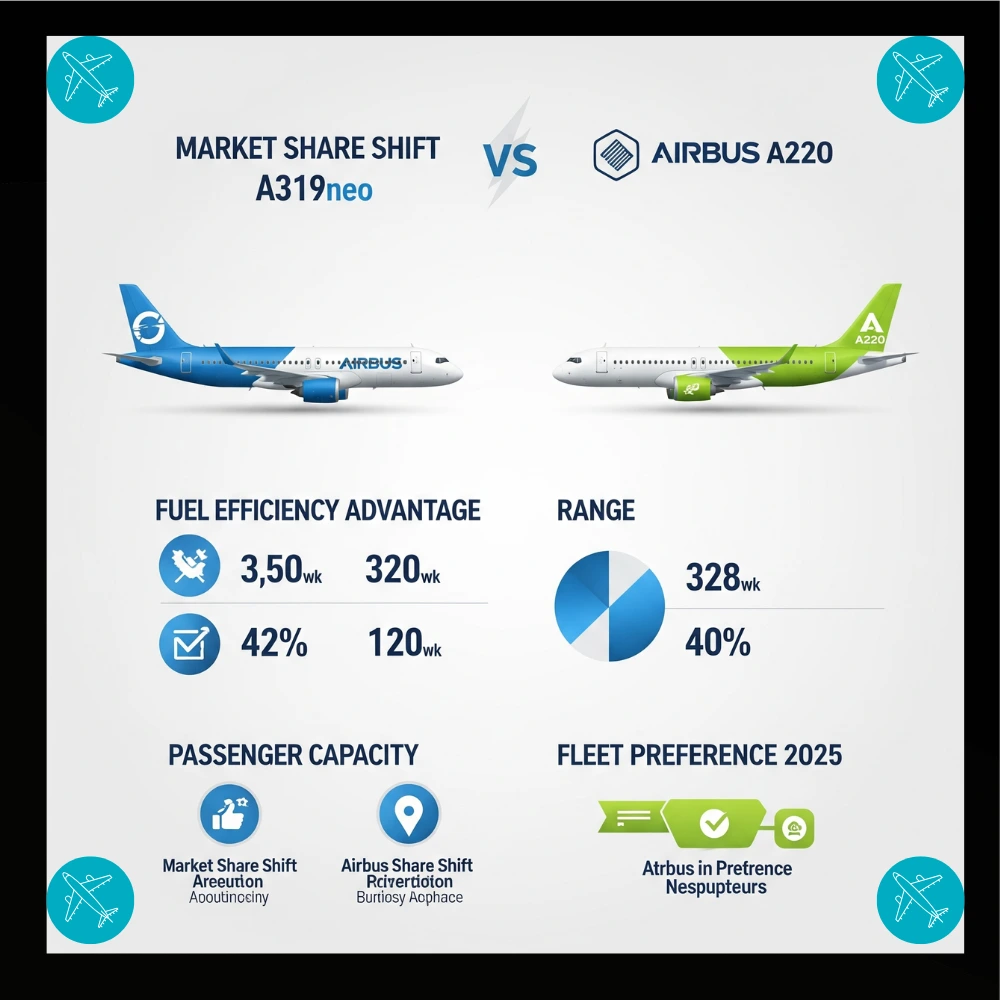
Shifting Preferences in the Narrow-Body Segment
As the A220 gains market ground, the A319neo struggles to maintain its niche appeal amid shifting airline preferences. Airlines around the world are turning toward more efficient, cost-effective options for regional and short-haul routes. While both aircraft serve a similar market, the A220-300 has become the favored choice due to its newer design, better fuel economy, and enhanced passenger comfort.
Why Airlines Prefer the A220 Over the A319neo
The Airbus A220-300 is considered a next-generation aircraft with significant advantages:
- Lower fuel burn per seat and superior operating economics
- The wider cabin and larger windows of the A319neo significantly enhance the passenger experience by offering a more spacious feel and improved natural lighting during flight.
- Modern systems and materials reduce maintenance needs
- Lighter airframe, ideal for low-density, high-frequency routes
Market Impact: Orders and Deliveries
- A220 Orders: Over 900 orders and 350+ deliveries as of 2025
- A319neo Orders: Only 61 total orders, with less than 15 delivered
- Notable A319neo Conversions: Spirit Airlines converted 31 A319neo orders into A321neos in response to better economics with larger models
- Most A319neo Customers are found in China or government and VIP segments, rather than mainstream commercial carriers
Limited Role in Airline Fleets
Most airlines now bypass the A319neo when evaluating new narrow-body aircraft. Even Airbus seems to prioritize promoting the A220 and A320neo families more aggressively, based on order fulfillment trends and global marketing efforts.
- Several carriers have dropped A319neo entirely in favor of either:
- Upgauging to the A320neo or A321neo (more seats = lower cost per seat)
- Switching to the A220-300 for regional operations (better economics for fewer passengers)
Future Outlook: Niche but Not Dead
Despite falling behind as the A220 gains market ground, the A319neo may still find a limited niche in:
- High-altitude airports (e.g., Lhasa) where performance is key
- Government and military use via Airbus Corporate Jets (ACJ)
- Low-frequency or regional routes in markets with infrastructure constraints
However, its commercial aviation future appears uncertain unless demand spikes in very specific operational environments.
Use Cases of Airbus A319neo Aircraft: Versatility Across the Skies
Commercial Passenger Transport
- Airbus aircraft are widely used by airlines for:
- Short-haul and long-haul operations (e.g., A320neo, A350, A380)
- Domestic routes, regional hops, and international services
- Low-cost carriers and full-service airlines alike (e.g., Ryanair, Lufthansa)
High-Altitude and Challenging Airports
- Airports with short runways or high elevations (e.g., Tibet, La Paz)
- Harsh weather and thin-air environments demand stronger takeoff performance, making the A319neo ideal for high-altitude and challenging airport conditions.
- Airlines operating in mountainous or isolated regions
VIP and Government Transport
- Presidential and governmental flights
- Private luxury travel with customized interiors
- Use by nations requiring long-range, secure transport
Military and Humanitarian Missions
- Troop transport
- Medical evacuation (Medevac)
- Disaster relief and logistics in remote areas
Training and Test Platforms
- Pilot training and systems testing
- Prototype technology evaluations
- Flight simulators and system validations in aviation academies
Cargo and Freight Conversion
- Converted into freighters to serve cargo-only airlines
- Used for e-commerce logistics and high-speed freight routes
Frequently Asked Questions: Airbus A319neo Aircraft
Q1: What is the main use of the Airbus A319neo?
A: The A319neo is primarily used for short- to medium-haul routes, especially where airport infrastructure is limited. It’s ideal for high-altitude airports, regional connections, and lower-demand markets that still need jet performance.
Q2: Is the A319neo used in military or government service?
A: Yes. The A319neo has VIP and military variants under the Airbus Corporate Jets (ACJ) and Multi Role Tanker Transport (MRTT) programs. Some governments use it for presidential transport, troop movement, or medical evacuation missions.
Q3: Can the A319neo land at smaller or high-altitude airports?
A: Absolutely. The A319neo is designed for challenging runways and airports at higher elevations, like those in Peru, Tibet, and Bolivia. Its performance makes it a top choice for such conditions.
Q4: Is the A319neo suitable for budget airlines?
A: Yes. Airlines like Allegiant Air and others operate the A319neo in an all-economy layout for point-to-point, cost-effective operations, making it perfect for ultra-low-cost carriers (ULCCs).
Q5: Are Airbus jets used for cargo operations too?
A: While the A319neo is not commonly converted to freighter, other Airbus models like the A330-200F and A321P2F (Passenger to Freighter) are extensively used for cargo transport globally.
Q6: How does Airbus support humanitarian missions?
A: Airbus aircraft, especially A400M and some converted commercial models, are used for disaster relief, emergency evacuations, and medical support, thanks to their payload capacity and range.
Final Verdict
The Airbus A319neo is a versatile, fuel-efficient aircraft that excels in both commercial and specialized operations. While it faces stiff competition from newer models like the A220, it remains a reliable choice for airlines needing performance at high-altitude airports, lower-capacity routes, or government and VIP transport. Its adaptability, advanced technology, and operational cost savings ensure it still holds strategic value in today’s evolving aviation market.
